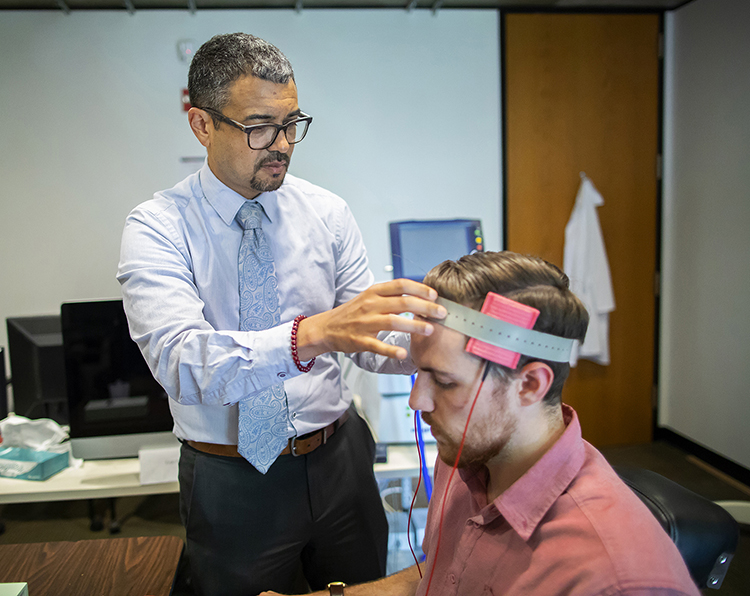Penn Medicine: Launching the Region’s First Center for Translational Neuromodulation

The brain is one of the most complex systems in the body, controlling movement, memory, communication, emotion, thought, and more. Unfortunately, serious diseases and injuries such as stroke, dementia, and psychiatric disorders can impede and disable core functions in the brain. Now, thanks to recent advances in neuroscience, neuroengineering, and other converging fields, experts are exploring the use of neuromodulation—noninvasive brain stimulation—to restore these functions in the brain, and Penn Medicine has launched a new center to study this science.
The Penn Brain Science, Translation, Innovation, and Modulation (brainSTIM) Center brings together a team of leading neuroscientists, neurologists, psychiatrists, psychologists, and engineers at Penn using neuromodulation techniques to research, repair, and enhance human brain function—the first translational center of its kind in the region.
The brainSTIM Center is being led by Roy Hamilton, an associate professor of neurology and physical medicine and rehabilitation at the Perelman School of Medicine at the University of Pennsylvania. The center will be a hub for developing new treatments that use neuromodulation—direct stimulation of the brain with electrical signals or magnets—to reorder, reorganize, and restore brain function in patients suffering from various types of neurological disorders such as dementia and stroke and psychiatric disorders like anxiety.
“Neuromodulation is a fascinating technology—it’s already successfully used to treat depression and we’ve led exciting research on brain stimulation and aphasia, a language disorder which impairs a person’s ability to communicate. But this is just the tip of the iceberg,” said Dr. Hamilton. “Our driving goal is to investigate how cognition works in the neural networks of the brain, uncover how to enhance those functions, and ideally develop new simulation-based therapies for our patients.”
The center uses a range of neuromodulation tools, including transcranial magnetic stimulation (TMS), and transcranial electrical stimulation (tES) techniques. By combining these technologies with advanced imaging tools, such as structural and functional magnetic resonance imaging, experts can explore key structure-function relationships in the brain that underlie human cognition and neural function.
Dr. Hamilton and fellow brainSTIM faculty members Branch Coslett, William N. Kelley Professor of Neurology, and John Medaglia, adjunct assistant professor of neurology at Penn and an assistant professor of psychology at Drexel University, are pursuing work funded by the National Institute on Deafness and Other Communication Disorders and the Department of Defense to determine whether transcranial direct current electrical stimulation (tDCS) of the brain can be used to slow the progression of language loss for those with primary progressive aphasia (PPA), a neurodegenerative condition that impairs communication ability.
Recent work from a team led by brainSTIM faculty Ted Satterthwaite, assistant professor of psychiatry, has shown that the functional networks of the brain responsible for self-control are highly variable in youth brain anatomy. They found that these networks are sculpted as adolescents develop into adulthood and are associated with individual differences in cognition. These personalized networks could be used to target neuromodulatory therapies in the developing brain.
Additionally, brainSTIM faculty Desmond Oathes, assistant professor of psychiatry, Danielle Bassett, J. Peter Skirkanich Professor of Bioengineering, and Dr. Satterthwaite are currently pursuing work funded by the National Institute of Mental Health to understand how TMS might improve working memory in healthy adults and those with ADHD by combining network control theory (a set of concepts and principles employed in engineering), magnetic stimulation of the brain, and functional brain imaging.
“Over the past 20 years I’ve witnessed remarkable advances in the ability of neuromodulation to influence brain circuits that drive functions, cognition, and behavior,” added Dr. Hamilton. “While these initiatives, and many others, are already underway at Penn, our hope is that the creation of the center will allow for even more collaboration and advancements, enabling us to provide more effective treatment options to our patients in the region and beyond.”
For more information about the brainSTIM Center, visit https://www.med.upenn.edu/brainstimcenter/
